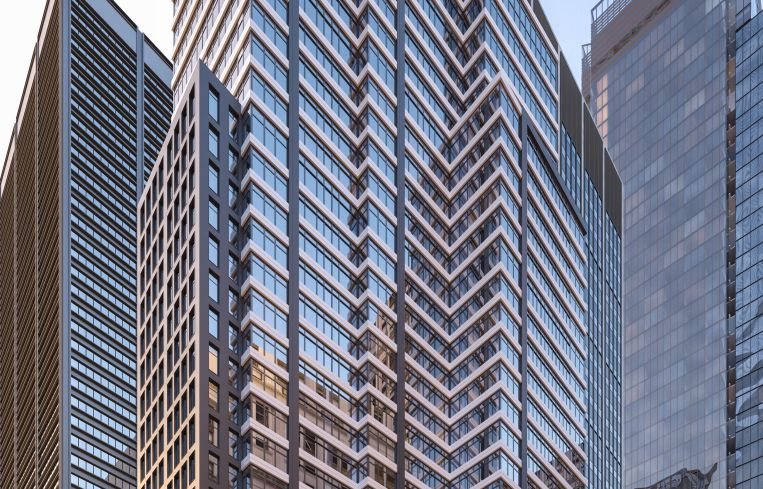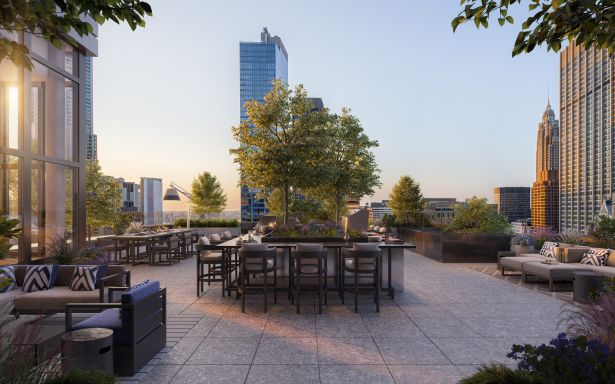New Lower Manhattan Tower Tackles Affordable Housing Void
Demand for 7 Dey Street underscores neighborhood’s need for more workforce apartments.
By Andrew Coen October 12, 2021 12:08 pm
reprints
In September, some 14,000 applications poured in for the 63 units at 7 Dey Street, the first residential tower built in Lower Manhattan under the state’s four-year-old Affordable Housing New York program, which replaced the 421-a tax incentive. The deluge highlighted the heavy demand for cheaper housing in the Financial District, a demand that the neighborhood’s post-9/11 revival never satiated.
Landlord SL Green Realty Corp. and brokerage Douglas Elliman began leasing the 209-unit, 34-story mixed-use tower in early September. The project was built in concert with Affordable Housing New York, a New York City tax incentive designed to spearhead more workforce units in newer multifamily properties. As such, 30 percent of the units are set aside for residents whose household incomes comprise 70 to 130 percent of the area median income (AMI), ranging from $45,566 to $167,570.
“The more of this type of development we can do [along with that by] any other developer in the city, clearly the better because look at the demand on the affordable side,” Brett Herschenfeld, managing director at SL Green, said during a late September tour of 7 Dey Street. “I think that the way that they designed the program was really, really well done and, obviously, here, it’s very successful.”
SL Green, which received an Affordable Housing New York tax exemption for the development’s affordable housing component, bought the building at 5-7 Dey Street and the adjacent building at 187 Broadway in 2015 as part of a $63.7 million acquisition. The development of 7 Dey Street was paved the way in part by SL Green purchasing air rights from the Metropolitan Transportation Authority.
The apartment building comprises 21 studios that with a 70 percent AMI are asking a monthly rent of $1,329 for household incomes ranging from $45,566 to $66,850, according to SL Green. The 260,000-square-foot property also features four other studios, 30 one-bedroom apartments and eight two-bedroom units for 130 percent of the AMI, or where the household income ranges from $86,503 to $167,570.
A 60-day lottery for the available units commenced on Sept. 3 with the nonprofit Settlement Housing Fund and the city Department of Housing Preservation and Development monitoring the program.
Carl Weisbrod, founding president of the Alliance for Downtown New York, a booster group, said the 14,000 applications for only 63 units at 7 Dey Street underscores New York City’s affordable housing challenges, especially in Lower Manhattan.
Weisbrod noted that the Financial District was historically largely a business neighborhood until the city began converting some office buildings for residential use in the mid-1990s when there was no affordability requirement. He said the city missed an opportunity to spearhead more affordable housing in Lower Manhattan after the Sept. 11, 2001, terrorist attacks on the World Trade Center.
“We were so focused on rebuilding in Lower Manhattan that we didn’t focus on affordable housing,” said Weisbrod of the city’s approach to reviving the area after the attacks. “We did see some new residential development in Lower Manhattan, but the requirement for affordable housing was negligible.”
Liberty Bonds issued by the U.S. government after the terrorist attacks were instrumental in revitalizing Lower Manhattan through $1.6 billion in tax-exempt financing for multifamily projects Downtown, according to Weisbrod. Only 5 percent of a project’s units had to be designated as affordable to qualify for the bonds, however. He said that while the area has lacked sufficient workforce developments in the last two decades, 7 Dey Street, coupled with plans for around 331 affordable units in a new residential tower at 5 World Trade Center are steps in the right direction.
“I think what is envisioned on the World Trade Center site is important for both Lower Manhattan and the city and, frankly, we should just keep going,” said Weisbrod, who was founding president of the New York City Economic Development Corporation under Mayor David Dinkins. “The issue in Lower Manhattan is the availability of development sites.”

The MTA’s Fulton Center, a key centerpiece of Lower Manhattan’s recovery from 9/11, is located directly across from 7 Dey Street, giving tenants quick access to several major subway lines. The World Trade Center Transportation Hub with links to the Port Authority of New York and New Jersey’s PATH system is also located down the street.
The debut this fall of 7 Dey Street, with some residents already moved in, arrives as the rental market in New York City bounces back after struggling through the pandemic in 2020. Case in point: the market-rate units at 7 Dey and their leasing pace. Six market-rate two-bedrooms are going for $8,900 a month each with all but one leased as of early October. One-bedroom apartments priced at $5,800 a month and studios at $5,100 a month are also commanding major interest.
“We have seen a truly extraordinary response to 7 Dey that has exceeded our expectations and allowed us to lease nearly 30 percent of the market-rate units in under six weeks,” Herschenfeld said. “We are getting strong interest across all unit types driven by young professionals coming back to New York and to the office with the unique ability to walk to work and everything Downtown has to offer.”
FXCollaborative designed 7 Dey Street with INC Architecture & Design crafting the property’s interiors. Its amenities include a coworking space, a fitness center, a club lounge, a boardroom and outdoor spaces with multi-level terraces.
Young professionals or couples working in finance or fashion have made up the bulk of market-rate tenants so far at 7 Dey, according to SL Green.
Weisbrod said he hopes projects like this spur more opportunities for working-class New Yorkers to live alongside young professionals in upscale housing that did not come to fruition post-9/11 because of so little focus on affordable housing in the Liberty Bond program.
“We were struggling to make sure that Lower Manhattan survived in the aftermath of 9/11, but I do think that we missed an opportunity there,” Weisbrod said. “We should be making it up now so that Lower Manhattan can have a greater mix of people of varying vocations, occupations, income levels and the like.”
Local leaders should take what’s happening with 7 Dey as a lesson in helping the city recover from COVID-19, Weisbrod said.
“We’ve seen after existential crisis after existential crisis, people want to be in New York,” he said. “It’s the most exciting and, in my view, most important city in the world, and, if we’re going to accommodate the kind of human talent that the city has always attracted, retained and grown, it’s essential that we provide the housing to be able to do that.”



